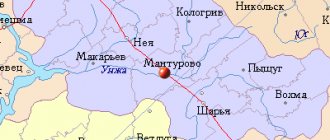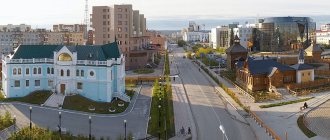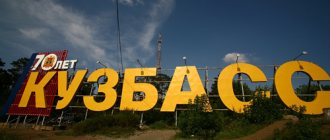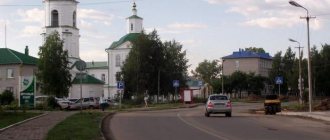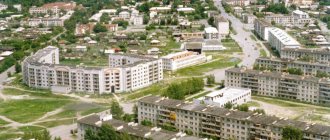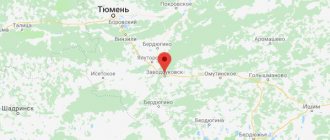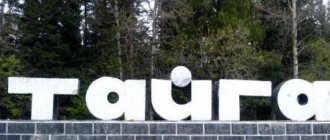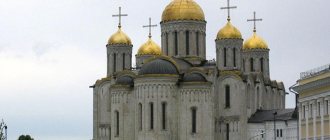Muravlenko
(Yamalo-Nenets Autonomous Okrug)
OKATO code:
71175
Founded:
1984
Urban settlement since:
1984
City since:
1990 City of district subordination
The city was formerly called:
| Muravlenkovsky | 1984 | 1990 |
| Telephone code (reference phone) | |
| 34938***** | — |
Deviation from Moscow time, hours:
2
Geographic latitude:
63°47′
Geographic longitude:
74°31′
Altitude above sea level, meters:
120 Sunrise and sunset times in the city of Muravlenko
Map
| Muravlenko: maps |
Muravlenko: photo from space (Google Maps) Muravlenko: photo from space (Microsoft Virtual Earth)
| Muravlenko. Nearest cities. Distances in km. on the map (in brackets along roads) + direction. Using the hyperlink in the distance , you can get the route (information courtesy of the AutoTransInfo website) | |||
| 1 | Noyabrsk | 79 (109) | SE |
| 2 | Gubkinsky | 120 (127) | NE |
| 3 | Purpe | 130 (135) | NE |
| 4 | Kogalym | 168 (200) | YU |
| 5 | Tarko-Sale | 201 (217) | NE |
| 6 | Nizhnesortymsky (Khanty-Mansiysk Autonomous Okrug - Ugra) | 204 () | SW |
| 7 | Nadym | 216 (626) | NW |
| 8 | Pangodas | 228 (492) | WITH |
| 9 | Novoagansk (Khanty-Mansiysk Autonomous Okrug - Yugra) | 231 (642) | SE |
| 10 | Wiggle it | 232 (300) | YU |
| 11 | Rainbow | 236 (591) | SE |
| 12 | Fedorovsky (Khanty-Mansiysk Autonomous Okrug - Ugra) | 245 (273) | YU |
| 13 | Lyantor | 269 (450) | SW |
| 14 | New Urengoy | 275 (400) | NE |
a brief description of
The city is located within the Salekhard Plain, 80 km from the railway. Khanymey station, 480 km southeast of Salekhard, 870 km northeast of Tyumen.
Territory (sq. km): 92
Information about the city of Muravlenko on the Russian Wikipedia site
Historical sketch
The first landing party landed on the site of the future city in October 1982. Founded in 1984 as the village of Muravlenkovsky in connection with the development and maintenance of oil fields (Muravlenkovskoye, Sutorminskoye, Krainee, Sugmutskoye and others) and gas. Named in honor of V.M. Muravlenko. City since August 6, 1990.
Municipal indicators
| Index | 2001 |
| Demography | |
| Number of births, per 1000 population | 12.7 |
| Number of deaths, per 1000 population | 3.7 |
| Natural increase (decrease), per 1000 population | 9 |
| Standard of living of the population and social sphere | |
| Average monthly nominal accrued wages, rub. | 11559 |
| Average housing area per inhabitant (at the end of the year), sq.m. | 15.9 |
| Number of preschool institutions, pcs. | 9 |
| Number of children in preschool institutions, thousand people | 2.2 |
| Number of daytime educational institutions (at the beginning of the school year), pcs. | 6 |
| Number of students in daytime educational institutions, thousand people | 6.5 |
| Number of doctors, people. | 142 |
| Number of nursing staff, people. | 402 |
| Number of hospital institutions, pcs. | 1 |
| Number of hospital beds, thousand units | 0.3 |
| Number of medical outpatient clinics, pcs. | 1 |
| Capacity of medical outpatient clinics, visits per shift, thousand units. | 0.3 |
| Number of registered crimes, pcs. | 499 |
| Persons who committed crimes were identified, persons. | 354 |
| Economy, industry | |
| Number of enterprises and organizations (at the end of the year), pcs. | 405 |
| Construction | |
| Volume of work performed by type of activity “Construction” (until 2004 - volume of work performed under construction contracts), million rubles. | 1330.8 |
| Commissioning of residential buildings, thousand sq.m. of total area | 1.1 |
| Commissioning of residential buildings, apartments | 23 |
| Commissioning of preschool institutions, places | 0 |
| Commissioning of educational institutions, places | 0 |
| Commissioning of hospital facilities, beds | 75 |
| Commissioning of outpatient clinics, visits per shift | 150 |
| Transport | |
| Number of bus routes (in intracity traffic), pcs. | 7 |
| Number of passengers transported by buses per year (in intracity traffic), million people. | 1.2 |
| Connection | |
| Number of residential telephone sets of the city public telephone network, thousand units. | 7 |
| Trade and services to the population | |
| Retail trade turnover (in actual prices), million rubles. | 1043 |
| Retail trade turnover (in actual prices), per capita, rub. | 28743 |
| Public catering turnover (in actual prices), million rubles. | 122.6 |
| Volume of paid services to the population (in actual prices), million rubles. | 351.3 |
| Volume of paid services to the population (in actual prices), per capita, rub. | 9679 |
| Volume of household services to the population (in actual prices), million rubles. | 13.2 |
| Volume of household services to the population (in actual prices), per capita, rub. | 364 |
| Investments | |
| Investments in fixed assets (in actual prices), million rubles. | 405.9 |
| Share of investments in fixed assets financed from budgetary funds in the total volume of investments, % | 24.2 |
Data sources:
- Regions of Russia. Main characteristics of the constituent entities of the Russian Federation: statistical collection. Goskomstat of Russia. - M:, 2003.
Economy
Oil and gas production departments "Sutrominskneft", "Muravlenkovskneft". "Noyabrskneftegazstroy", gas processing plant. Motor transport enterprises.
Suburban and private farms raise pigs and cattle. Cucumbers, tomatoes, radishes, and greens are grown (in greenhouses).
In the surrounding area there is oil and gas production. Reindeer husbandry.
Universities of the city
Branch of the Tyumen State Oil and Gas University in Muravlenko
629603, Yamalo-Nenets Autonomous Okrug, Muravlenko, st. Neftyanikov, 67
| Population by year (thousands of inhabitants) | |||||||
| 1989 | 23.1 | 2003 | 35.9 | 2011 | 33.4 | 2017 | 32.5 |
| 1992 | 26.7 | 2005 | 36.8 | 2012 | 33.5 | 2018 | 32.4 |
| 1996 | 35.0 | 2006 | 37.0 | 2013 | 33.2 | 2019 | 32.1 |
| 1998 | 36.9 | 2007 | 37.1 | 2014 | 33.0 | 2020 | 31.6 |
| 2000 | 36.2 | 2008 | 37.1 | 2015 | 32.8 | 2021 | 31.4 |
| 2001 | 36.3 | 2010 | 37.3 | 2016 | 32.6 | ||
Special project "UralPolit.Ru". Cities. Muravlenko
The expert information channel "UralPolit.Ru" continues the special project "Cities", which tells about the most interesting settlements of the Urals and Siberia.
The expert information channel "UralPolit.Ru" continues the special project "Cities", which tells about the most interesting settlements of the Urals and Siberia.
We present to our readers information about the city of Muravlenko, Yamalo-Nenets Autonomous Okrug.
a brief description of
The city of Muravlenko is located within the Salekhard Plain, 80 km from the railway. Khanymey station, 480 km southeast of Salekhard, 870 km northeast of Tyumen.
The territory of this settlement is 92 square meters. km. The first construction landing landed on the site of the future city back in October 1982. And in 1984, in connection with the development and maintenance of oil fields (Muravlenkovskoye, Sutorminskoye, Krainee, Sugmutskoye and others) and gas, the village of Muravlenkovsky was founded here, which was named in honor of Viktor Ivanovich Muravlenko . On August 6, 1990, the village was awarded the title of city.
City `s history
At first, there was a lot of controversy about the name of the future city. Some suggested calling it Nefteozersk, others - Trekhozerny, but the village was named after Viktor Ivanovich Muravlenko, a man under whose direct leadership and with whose participation Western Siberia turned into the largest oil-producing region of the country. Here, in the Tyumen North, when Viktor Ivanovich became the first head of Glavtyumenneftegaz, his talent as a major production organizer most fully manifested itself. In a short time, under very difficult conditions, he managed to create an active, friendly team capable of solving the grandiose tasks of accelerated industrial development of this rich region.
The city of Muravlenko owes its birth to the industrial development of the Muravlenkovo group of oil fields, the first of which was discovered Sutorminskoye - one of the largest in Western Siberia. Exploration well R-31, drilled on August 30, 1975, with a fountain of waterless oil, heralded a new stage in the life of this land.
The site for the development of the then unnamed settlement was allocated by order of the Tyumen Regional Executive Committee in November 1980, and the general construction plan was approved in early April 1982. The year of foundation of the settlement is considered to be 1983.
Petroleum specialists and those who wanted to change their measured lifestyle to hectic shifts at drilling rigs and pumping stations, or even start a new life in life, began to come from many regions of the Soviet Union. By the beginning of 1984, 1,600 people already lived in the village. A dining room with 40 seats, a store, a medical outpatient clinic, an automatic telephone exchange with 200 numbers, and a television installation of the “Screen” type were built. In the same year, 33,834 sq. m. were put into operation. m of wooden housing, a bathhouse-laundry and a number of other facilities. Since 1987, the streets of the Muravlenkovsky village have names - Lenina, 70 Let Oktyabrya, Pionerskaya, Novoselov Lane and others. The village council of people's deputies decided to approve public transport routes: two buses began to operate on two routes. And the first intercity route - to neighboring Noyabrsk - was opened in April 1985.
In 1990, another significant event occurred in the history of Muravlenko: by Decree of the Presidium of the Supreme Soviet of the RSFSR, the village of Muravlenkovsky became a city of district subordination. The document was signed by the Chairman of the Supreme Council of the RSFSR, Boris Yeltsin.
Specialists came here from all over the Soviet Union - oil workers, builders, transport workers, teachers, medical workers. They came with families, with children. However, over the last decade the population has been growing much more slowly: if at the beginning of 1992 there were 27.5 thousand people living in the city, then on January 1, 1995 - 34.2 thousand, and on January 1, 1999 - 36.9 thousand inhabitants. Currently, a little more than 37 thousand people permanently reside in the city, as well as over 4 thousand with a residence permit and shift workers.
People of more than 70 nationalities live in Muravlenko. The ethnic composition of the population is quite diverse. The largest national groups are Russians, Ukrainians, Tatars, Belarusians, and Bashkirs. The North is often compared to America - it united representatives of several dozen large and small nations. Various national groups have a great influence on the formation of urban communities.
Geographical position
The city of Muravlenko is located in the northern taiga subzone in the Purovsko-Sredneobsky forest region.
In general, the territory under consideration is characterized by a flat topography, which causes weak surface runoff and widespread surface swamping of the territory. Relief depressions are occupied by lakes, which, as a rule, have a round shape with an area of up to 0.1-0.2 square meters. km, less often up to 1.0 sq. km. The depth of the lakes is 0.4-0.8 m.
Most of the territory within the city limits is occupied by natural landscapes of varying degrees of disturbance due to the development of deposits and the placement of urban infrastructure facilities.
During the short northern summer, berries ripen in the swamps: cloudberries, blueberries, and along the edges of the swamps - lingonberries.
The species diversity of the fauna is not rich and amounts to about 15 species. Terrestrial vertebrates are represented mainly by small mammals, amphibians and birds. Reptiles and large mammals are rare.
Climate
The climate of the Muravlenko region is sharply continental with harsh snowy winters and relatively cool summers. Stable frosts last 190 days a year, the duration of the frost-free period is about 90 days. The average annual air temperature is minus 6.7 degrees C.
The coldest month is January with an average monthly temperature of minus 25 degrees. The absolute minimum was recorded in February – minus 61 degrees. Stable frosts last from the second half of October until the end of April. Snow cover forms in October and lasts on average 209 days, its height is 55-70 cm.
Summer is short, dry, moderately cold with a relative humidity of 69-77%. The duration of the period with an average daily air temperature above 15 degrees is 40-50 days. The absolute maximum is observed in June-July and is plus 34 degrees. In the long-term average temperature range, the last frost occurs in mid-July. The duration of the growing season is 111 days.
The duration of sunshine is 1566 hours, of which 700 hours are observed in the summer (July - August). The area belongs to a zone of severe ultraviolet radiation deficiency. During December - January, direct solar radiation does not reach here at all.
Thus, the climatic conditions of the area are hypocomfortable, which is determined by low air temperatures, high wind speeds in winter and frequent snowstorms, and a significant ultraviolet deficit.
Landmarks and famous places
Today, a network of cultural institutions operates stably in the city, providing a variety of cultural services to the population; cultural traditions have been formed (city public holidays, professional and national holidays, permanent amateur creative groups). There is a positive dynamics of growth in the coverage of the population with socio-cultural services provided by cultural institutions.
The city’s network of cultural institutions covers almost all areas of cultural and leisure activities, providing the population with services in the field of library services, museum affairs, additional education for children of an artistic and aesthetic orientation, and organization of leisure activities (amateur artistic creativity, video screening, concert activities). In total, there are 11 cultural institutions in the city: 4 libraries, a children's art school, a children's music school, a children's art school, an Ecological and Local Lore Museum, a city recreation center "Ukraine", a children's choreographic studio "Rhythm", as well as a park of culture and recreation.
Within the city limits in the southern part of the city there is a system of shallow lakes with gentle banks. On the city side, the shores of the lakes and the pine forest area have been landscaped: a park landscape has been created, a pier has been built, and a beach has been organized. Thus, a green recreation area was formed on the southern outskirts of the urban area. In summer, the reservoirs are suitable for swimming. A young pine forest and the smooth surface of the water create a picturesque landscape, the air is saturated with oxygen and phytoncides.
The main types of recreation common among city residents in the summer are berry picking, fishing and hunting. Only a few days (weeks in a good summer) are bivouac-type rests, swimming, and sunbathing possible. The recreational potential of the territory in winter is limited by the harsh climate with prolonged severe frosts and winds, and in summer by the presence of a large number of blood-sucking insects.
The city has at least 11 cafes, 2 bars and 2 canteens.
Main enterprises
The city lives mainly from the oil industry. Oil production is carried out by Gazprom Neft OJSC. The energy supply of the city is entrusted to OJSC Tyumen Energy Sales Company. In addition, Service Transport Company LLC conducts its activities in the city (the company’s activities include transport plugging services).
How to get there
By plane or train to the city of Noyabrsk, and then 109 km in a north-west direction by road, and you will find yourself in the city of Muravlenko. You can also take the train to Hanemey station, which is located a little closer - 80 km from the city - and then again by car. Another nearby relatively large settlement, the city of Gubkinsky, is located 127 km to the northeast.
Hotel costs
The four-story Rus Hotel, located on Gubkin Street in the city of Muravlenko, opened its doors to city guests in 2004. In total, the hotel has 45 single and double rooms, which can simultaneously accommodate 70 people. Single rooms consist of a bedroom and a bathroom, while double rooms also have a living room. Perfect cleanliness, new light furniture, carpets on the floor, paintings on the walls. Some rooms have air conditioning and flowers. The rooms are equipped with flat-screen TVs, refrigerators, and telephones. The bathrooms have rugs, soap and shampoo, as well as snow-white terry robes and a set of the same towels. The living rooms of double rooms have a coffee table and upholstered furniture. In the hotel building there is a cafe where you can sit quietly, drink a cup of coffee or a glass of wine, or you can have a delicious meal by making a reservation. The lowest cost of hotel accommodation is 1800 rubles/day for a single room. A double room will cost city guests 3,200 rubles per night. Luxury – 3900 rubles.
Honorary residents of the city
The list of honorary residents of the city of Muravlenko includes 5 people: Muravlenko Sergey Viktorovich, Trinev Remislav Pavlovich, Tomashevsky Alexander Kazimirovich, Kurmaz Yuri Ivanovich and Dolin Valentin Evgenievich.
3 reasons to come to the city
Firstly, in Muravlenko, as well as throughout the Yamal-Nenets Autonomous Okrug, wages are quite high in relation to the more southern and western territories of Russia, so many shift workers and oil workers come to the city to improve their financial condition.
Secondly, you can come to Muravlenko for the sake of the colorful northern nature, if a person is ready to put up with long winters and severe frosts. And the environmental situation in the municipal area is quite favorable compared to large industrial cities. Muravlenko may seem attractive to those who like fishing, hunting, picking mushrooms and berries.
Finally, Muravlenko is one of the few cities in Yamal, which is located relatively close to the “mainland” and the largest city of the autonomous region - Noyabrsk. It is not that difficult to get to at any time of the year.
3 reasons to leave the city
One of the main reasons to leave this environmentally friendly city is the harsh climate. Severe frosts, long winters, polar nights, short-term cold summers and an abundance of blood-sucking insects during the warm period will not please anyone.
In addition, this town can hardly be called a youth town, since there are quite a few places for entertainment and varied recreation. You will hardly be able to see performances of famous musical groups and troupes of famous theaters in Muravlenko. Therefore, in general, leisure time in the city can be considered monotonous and lackluster.
And if a measured and quiet life is not for you and you want greater opportunities for self-development, then with great success you will be able to realize your ambitions in a larger city with a million population. The material was prepared on the basis of open public sources.
